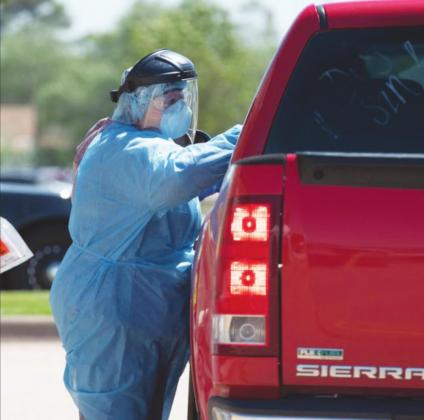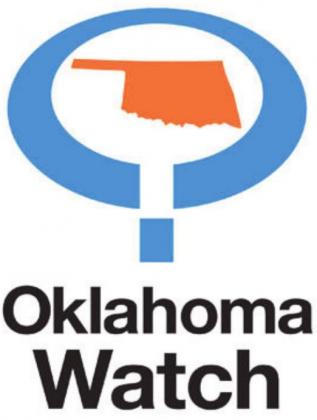In early April, Oklahoma was reporting one of the lowest COVID-19 testing rates in the country as health officials struggled to locate supplies and convince private labs to tally their numbers more quickly.
Weeks later, the testing picture has changed.
Gov. Kevin Stitt said Tuesday that testing for the deadly virus is up 36% from earlier this month. The state’s testing capacity, including access now to tens of thousands of new saliva tests, has grown so much that Stitt wants 40,000 nursing home residents and staff tested over the next month. And for the first time, he is urging Oklahomans to get a test if they want, even if they are not showing symptoms or haven’t been exposed to someone who tested positive.
But is more testing still needed?
An Oklahoma Watch analysis of the testing numbers shows that the state has not met benchmarks recommended by White House officials and some public policy groups for states to safely reopen.
Experts say rushing to reopen without adequate testing could risk a second wave of infections in states if they aren’t able to quickly identify and quarantine.
About 63,800 tests in Oklahoma have been processed since the pandemic broke out, according to the state’s daily reports. The state now ranks 24th in number of in testing when adjusted for population. It has averaged 2,322 tests per day over two weeks – a pace that would put it on track to perform nearly 70,000 tests per month. That represents about 17 tests per 1,000 residents.
The White House didn’t include specific testing benchmarks to guide states in its phased reopening plan.
But Dr. Deborah Brix, the coronavirus response coordinator for the Trump administration, said earlier this month that states should aim to achieve 30 tests per 1,000 residents a month.
Oklahoma is among 37 states that have failed to meet this goal, a Washington Post review found.
Several private policy groups have issued their own guidelines. These include a recommendation from Nobel Prize-winning economist Paul Romer that 7 percent of the nation’s population be tested daily. In Oklahoma that would mean 276,990 residents per day. Another one from Scott Gottlieb, a former FDA commissioner, calls for testing about 1 percent of the population per week, which equates to about 39,570 Oklahomans. Oklahoma would need to more than double its testing numbers to meet this.
In an American Enterprise Institute report, Gottlieb and co-authors wrote that this level would allow states to test those with symptoms and others they were in contact with, hospitalized patients, health care workers and other essential workers in health or public safety roles.
Testing in Oklahoma
Stitt and other state officials have said they are confident that the state is ready for the May 1 reopening.
But the governor stressed during his news conference April 28 that Oklahoma is “still not out of the woods yet” and urged residents to help boost the state’s testing numbers.
Stitt said residents can call 211 to schedule an appointment and see if there are testing locations nearby.
Oklahoma Commissioner of Health Gary Cox expanded on that call Thursday when he announced the state wants to test an additional 90,000 residents, or roughly 2% of the state, by the end May.
“Your participation will help us expand our knowledge on what is the level of community spread and what is the number of folks who (test positive) who are asymptomatic,” he said. “These critical efforts will identify people who have been exposed but don’t know it.”
In tandem with this, he said the state plans to boost the number of contact tracers, who work to track down anyone exposed to someone who tested positive for COVID-19. The state plans to double the number to 300 tracers by next week and eventually hire 1,000 tracers.
Oklahoma can offer testing to whoever wants it now because, according to State Department of Health data, 63,327 testing kits were available as of Wednesday, up from 40,551 two weeks ago.
In addition, the more than three dozen public or private labs working with the state report they have the capacity to process a total of more than 70,000 tests per day. Last week, OU Medicine, the University of Oklahoma Health Sciences Center and the Oklahoma Medical Research Foundation announced they are collaborating on a new test to allow the OU health-care system to test up to 180,000 samples over the next 90 days.
Aaron Wendelboe, interim state epidemiologist, said there are ample tests now to meet current needs and the projected demand for those seeking a test. He said locations continue to expand, with now 80 drivethru testing locations up and running across the state.
Unlike earlier, Wendelboe said, there is no current shortage of reagents, which are chemicals used to process the tests. The main limitation to expanding testing is consistent access to the long nasal swabs needed to administer most tests.
“Which is why the state is positioning itself to be on the front end of saliva testing,” he said. “The state has the capacity to process 25,000 tests a week, thanks to partnerships with Oklahoma State University and University of Oklahoma.”
The saliva tests are not only more available, but are less invasive and are easier and quicker to administer.
At Tuesday’s press conference, Oklahoma Deputy Secretary of Health and Mental Health Carter Kimble said saliva tests will be used to help meet the state’s goal of testing 42,000 nursing home residents and staff over the next month. Long-term care facilities have been hit hard by the virus.
Donelle Harder, a health department spokeswoman, said there are plans for these tests to also be offered at drivethru locations. The tests are “the key to taking our drivethru testing locations to the next level of surveillance and tracing,” she said.
Funding for these tests will come from part of the $1.2 billion in federal stimulus money Oklahoma will receive, she said.
Harder added the state will soon announce plans to expand testing of first responders, health workers and others.
Questions on Antibody Tests
So far, the focus has been on testing for the presence of the virus as health officials race to treat and quarantine thousands who were infected.
But state officials are quietly mulling how to roll out antibody tests on a large scale.
Antibody tests identify people who had the virus and may not have known it but who have recovered. In theory, the presence of antibodies suggests some level of immunity that prevents, or reduces the likelihood of, re-infection.
But several studies have raised concerns about the accuracy of antibody testing. Experts have also cautioned that a positive antibody test doesn’t guarantee immunity.
The state health department oversaw a 1,000-person study looking for COVID-19 antibodies in a randomized group of Oklahomans without symptoms. The study found the presence of antibodies in a small fraction of subjects. Wendelboe said more studies are ongoing, with the purpose of understanding community spread and the extent of asymptomatic individuals.
Several private labs have also begun offering antibody testing.
That includes Oklahoma City-based Diagnostic Laboratory of Oklahoma, which began offering the tests last week. It will have a capacity to process 3,400 test per day.
Kim Holloway, the firm’s chief operations officer, said the lab currently is only processing tests ordered by a physician. But it is exploring options to soon offer the tests commercially to anyone who wants one, he said.
Dr. Rao Madhusudan, medical director for Diagnostic Laboratory, said the tests have limitations because scientists are still studying the virus to figure out whether infected people gain some type of immunity.
But he said this type of testing will be important moving forward.
“The main reason is to gather data,” he said. “This can give us a handle on how widespread the exposure has been in a given community.”
Oklahoma Watch is a nonprofit, nonpartisan media organization that produces in-depth and investigative journalism on a range of public-policy issues facing the state. For more Oklahoma Watch content, go to www.oklahomawatch.org.


